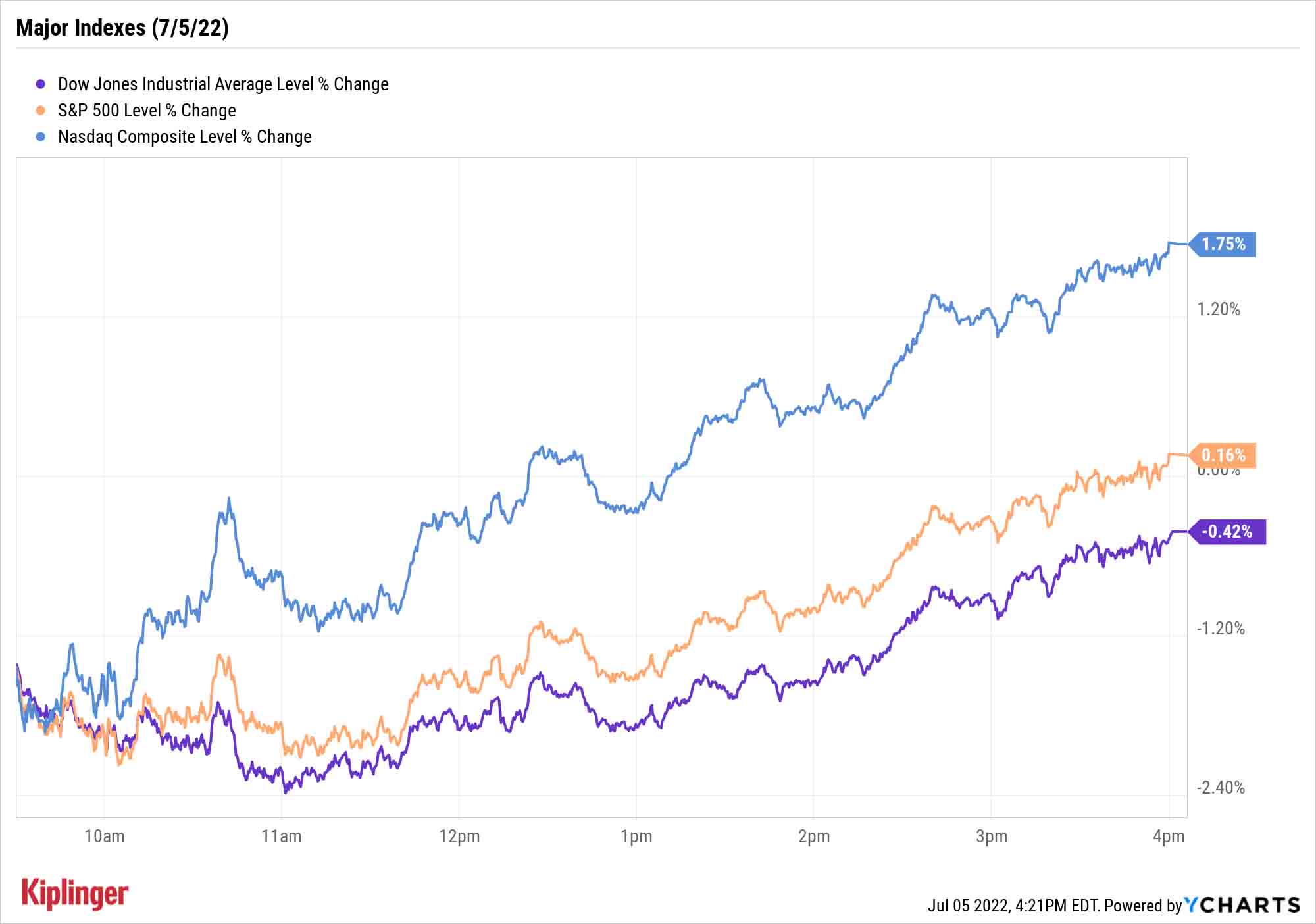Stock Market Today: Energy Dampens Dow, FAANGs Elevate Nasdaq
Recessionary fears weighed on oil and economically sensitive sectors Tuesday, while declining Treasury yields lifted tech-esque stocks.


The first session of the holiday-shortened week was a wild one, as a deep Tuesday morning dip evolved into a severely split market featuring pockets of red and green alike.
On one side, you had big dips in economically sensitive sectors. Energy (-4.0%) fared the worst thanks to a drastic decline in U.S. crude oil futures, which plunged 8.2% to $99.50 – the commodity's lowest finish in more than two months.
"This move came on the back of an ever-increasing number of economic indicators (Goldman Sachs US Financial Conditions Index, Citi US Economic Surprise Index, ISM orders) now pointing to sustained weakening of financial conditions as well as Street expectations," says Michael Reinking, senior market strategist for the New York Stock Exchange.

Sign up for Kiplinger’s Free E-Newsletters
Profit and prosper with the best of expert advice on investing, taxes, retirement, personal finance and more - straight to your e-mail.
Profit and prosper with the best of expert advice - straight to your e-mail.
Also weighing on oil was a strengthening U.S. dollar, which closed the session at a 19-year high. (Remember: Oil is priced in U.S. dollars, so a strong dollar will weigh on oil prices, and vice versa.) The aforementioned worries of weakness hampered other sectors, too, including materials (-2.0%) and industrials (-1.5%).
"Shifting to a more near-term view, with commodity prices coming a bit back down to reality, some investors may view this as a welcome sign that inflation is beginning to cool – the main driver of recent volatility," adds Chris Larkin, managing director of trading for E*Trade.
However, other parts of the market – namely, those pinned to the ground by rising interest rates – came off the mat as recent weakness in Treasury yields continued.
The 10-year T-note yield fell as low as 2.78% on Tuesday, sending communication services (+2.4%) and consumer discretionary (+2.2%) stocks higher. Facebook parent Meta Platforms (META, +5.1%), Google parent Alphabet (GOOGL, +4.2%) and Amazon.com (AMZN, +3.6%) – all members of the "FAANGs" – were among the session's noteworthy winners.
That resulted in markedly divergent results among the major indexes, which all finished well off their morning lows. The Dow Jones Industrial Average, led lower by Chevron (CVX, -2.6%), dipped 0.4% to 30,967, while the S&P 500 finished with a tame 0.2% uptick to 3,831. The Nasdaq Composite, however, popped 1.8% to 11,322.

Other news in the stock market today:
- The small-cap Russell 2000 gained 0.8% to 1,741.
- Gold futures, also weighed down by a strong dollar, closed off 2.1% to $1,763.90 per ounce, marking their lowest settlement of 2022.
- Bitcoin strengthened as the day went on, recovering by 5.4% to $20,397.00. (Bitcoin trades 24 hours a day; prices reported here are as of 4 p.m.)
Buy the Dip in Emerging Markets?
Inflationary pressures (and related stock-market pain) are hardly exclusive to investors in U.S. equities. For instance, the iShares MSCI Emerging Markets ETF (EEM) – one of the most popular funds holding emerging markets stocks – entered bear-market territory this year and is currently off 19% year-to-date.
Like with anything that's down, investors might put EMs on their buy-the-dip list. BofA Securities does warn that a comeback isn't necessarily imminent – but emerging markets won't be down forever.
"We stay bearish into the summer but see emerging long-term value. Don't turn bullish before central banks panic about recession more than inflation," say BofA's David Hauner and Claudio Irigoyen. But they add that "2023 is starting to come into focus: it might get better for EM. The EM-US growth differential is one of the more reliable top-down indicators. For 2023, our mid-year forecast update implies the best such number in a decade."
Thus, investors would do well to at least start building their EM wish lists.
But if you find individual names to be a bit too risky, emerging markets mutual funds allow you to enjoy some of this category's explosive upside while decreasing the chances that a single-stock blow-up will torpedo your portfolio. We look at five top emerging market funds.
Get Kiplinger Today newsletter — free
Profit and prosper with the best of Kiplinger's advice on investing, taxes, retirement, personal finance and much more. Delivered daily. Enter your email in the box and click Sign Me Up.
Kyle Woodley is the Editor-in-Chief of WealthUp, a site dedicated to improving the personal finances and financial literacy of people of all ages. He also writes the weekly The Weekend Tea newsletter, which covers both news and analysis about spending, saving, investing, the economy and more.
Kyle was previously the Senior Investing Editor for Kiplinger.com, and the Managing Editor for InvestorPlace.com before that. His work has appeared in several outlets, including Yahoo! Finance, MSN Money, Barchart, The Globe & Mail and the Nasdaq. He also has appeared as a guest on Fox Business Network and Money Radio, among other shows and podcasts, and he has been quoted in several outlets, including MarketWatch, Vice and Univision. He is a proud graduate of The Ohio State University, where he earned a BA in journalism.
You can check out his thoughts on the markets (and more) at @KyleWoodley.
-
 Stock Market Today: Stocks Soar on China Trade Talk Hopes
Stock Market Today: Stocks Soar on China Trade Talk HopesTreasury Secretary Bessent said current U.S.-China trade relations are unsustainable and signaled hopes for negotiations.
By Karee Venema
-
 2026 Disney Dining Plan Returns: Free Dining for Kids & Resort Benefits
2026 Disney Dining Plan Returns: Free Dining for Kids & Resort BenefitsPlan your 2026 Walt Disney World vacation now. Learn about the returning Disney Dining Plan, how kids aged three to nine eat free, and the exclusive benefits of staying at a Disney Resort hotel.
By Carla Ayers
-
 Stock Market Today: Stocks Soar on China Trade Talk Hopes
Stock Market Today: Stocks Soar on China Trade Talk HopesTreasury Secretary Bessent said current U.S.-China trade relations are unsustainable and signaled hopes for negotiations.
By Karee Venema
-
 Stock Market Today: Dow Drops 971 Points as Powell Pressure Ramps Up
Stock Market Today: Dow Drops 971 Points as Powell Pressure Ramps UpPresident Trump is increasing his attacks against Jerome Powell, insisting the Fed chair cut interest rates.
By Karee Venema
-
 Stock Market Today: No 'Powell Put'? No Problem
Stock Market Today: No 'Powell Put'? No ProblemInvestors, traders and speculators look beyond both another Trump post and more signs of slowing economic activity.
By David Dittman
-
 Stock Market Today: Dow Drops 699 Points After Powell Speech
Stock Market Today: Dow Drops 699 Points After Powell SpeechFed Chair Powell warned of a slowing economy and higher inflation but said the central bank isn't ready to cut rates just yet.
By Karee Venema
-
 Stock Market Today: Stocks Struggle Amid Tariff Uncertainty
Stock Market Today: Stocks Struggle Amid Tariff UncertaintyBoeing dropped after China suspended new aircraft orders, while Bank of America and Citi climbed on earnings beats.
By Karee Venema
-
 Stock Market Today: Stocks Gain on Tech, Auto Tariff Talk
Stock Market Today: Stocks Gain on Tech, Auto Tariff TalkThe Trump administration said late Friday that it will temporarily halt tariffs on some Chinese tech imports.
By Karee Venema
-
 Stock Market Today: Stocks Surge to Close a Volatile Week
Stock Market Today: Stocks Surge to Close a Volatile WeekIt was another day with a week's worth of both news and price action, but it ended on a strongly positive note.
By David Dittman
-
 Stock Market Today: Uncertainty Proliferates: Dow Loses 1,014 Points
Stock Market Today: Uncertainty Proliferates: Dow Loses 1,014 PointsWeaker-than-expected consumer inflation data wasn't enough to stabilize sentiment during another volatile day for financial markets.
By David Dittman